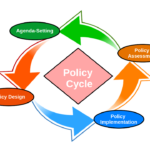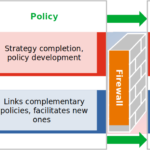Contention at its core involves claim-making activities that bear on someone else’s interests (Tilly and Tarrow 2007: 4). Contentious politics represent the intersection between contention, politics and collective action. It is defined as “episodic, public and collective” claims made by one or more parties where the state is involved as either the object of such claims or as part of them; and the outcome of such events will result in gains or losses of power by at least one of the claimants” (McAdam et al. 2001: 5).
The state is an essential actor in contentious politics as the state controls resources and thus has advantages over most other claimants. It sets the rules of engagement and, therefore the rules for contention. It also manages substantial coercive means and usually has a monopoly over the means of that coercion (Tilly and Tarrow 2007: 5).
This means that collective political struggles can include many different kinds of activities on the collective action spectrum, from labor strikes to revolutions – and significant for our purposes is that democratic governance itself is one possible outcome of these contentious episodes; collective political struggles can demonstrate for leaders the necessity of including people in decision-making.
Following from this, there are two main types of contention: contained contention in which claim-making falls within a state’s ‘prescribed’ or ‘tolerated’ institutional forms, and in which often, parties in a dispute are already established political actors; and transgressive contention in which claims cross institutional boundaries into ‘forbidden’ territory, and where often new political actors enter the scene and employ new forms of claim-making (Tilly and Tarrow 2007: 60-61; McAdam 2001: 7-8). While Tilly et al. claim the boundaries often blur between contained and transgressive contention, the principles are that governmental regimes set the limits on what is acceptable for claim-making. They establish what is promoted, what is tolerated and what is forbidden. Moreover, governments also vary dramatically in their ability to keep those limits in check.
Transgressive conflicts
When transgressive contention turns lethal, it is often because of the state’s lack of capacity to tolerate and mediate that contention – and the government itself, or challengers/competitors of that authority – turn to armed force to push through their claims. In these cases, violence is not a “byproduct” of nonviolent claims but is rather the central rationale of claim-making, representing cases where “governments and other political actors regularly use organized armed force” to make their demands (Tilly et al. 2007: 136). Conflicts can range from violent ethnic or religious conflict to civil wars to full-scale revolutions. Lethal conflicts have characteristics that make them different from other forms of contentious politics, namely, the claim-making processes have very high stakes – they are very destructive and deadly – and the claim-makers themselves have to be able to sustain the armed force (ibid.: 136-137). “Unlike recruiting people for demonstrations or public meetings, creating and maintaining an armed force requires extensive resources… they… need weapons, ammunition, information, means of communication, and personnel to replace those they lose” (ibid.: 137).
The location and possibility for large-scale lethal conflict are also by and large shaped by the character of a regime, including the central government’s capacity and the degree of democratic governance. Indeed, on the less lethal end of contention, social movements arise disproportionately in countries that are more open or are in the process of opening. By contrast, large scale, deadly conflicts disproportionately take place in low-capacity, non-democratic countries that rarely, if ever, see social movements as part of the regular political landscape of citizen contention. There are also more dramatic possible outcomes in large-scale conflicts, namely either a split in the regime itself or a complete transfer of power.
At the same time, there are also many overlapping traits between deadly conflicts and non-lethal social movements. That means that there are many “similar causes and effects [that[ operate across the whole range of contentious politics, from viciously violent to pristinely peaceful… through a combination of mobilization, brokerage, diffusion, certification and boundary activation” (Tilly et al. 2007: 160-161).





